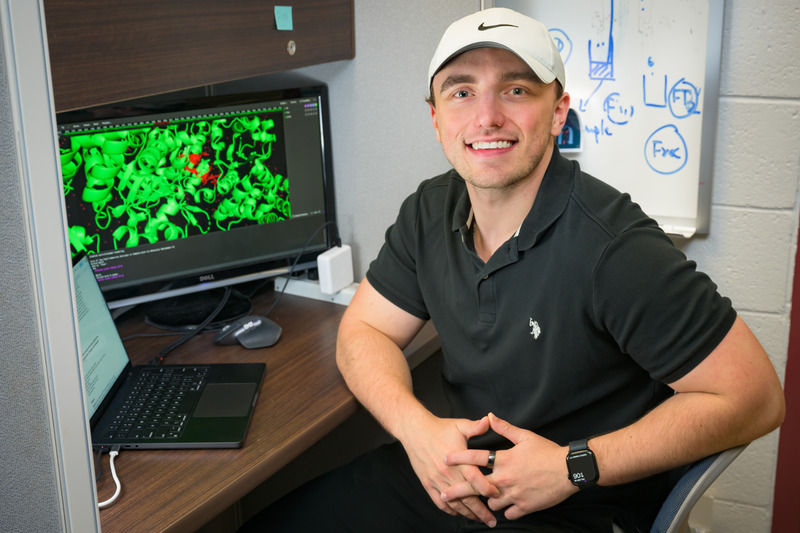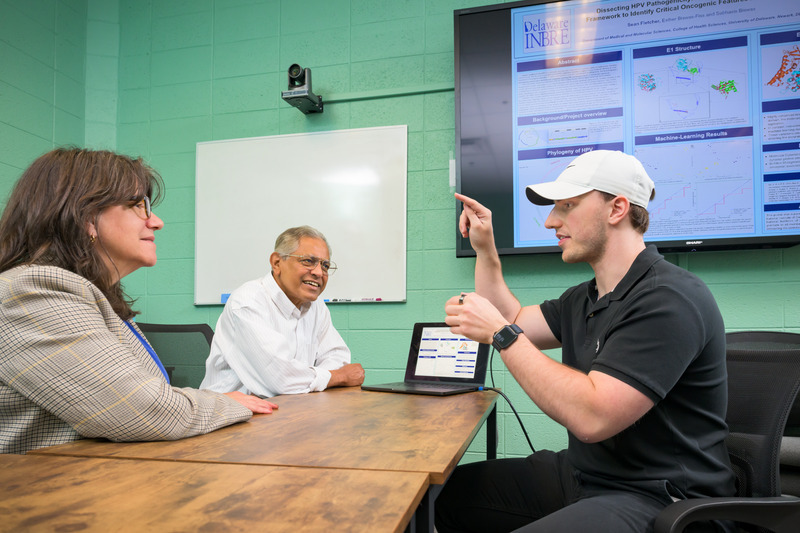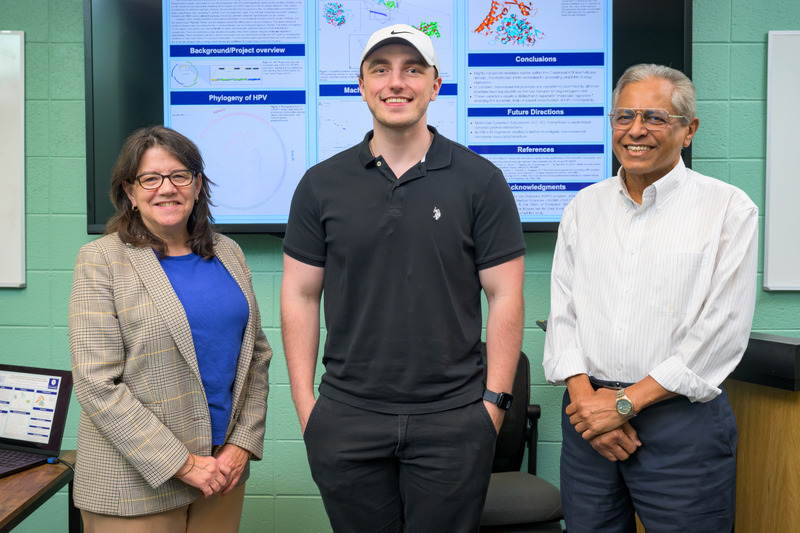


The power of undergraduate research
Photos by Evan Krape October 16, 2025
First-generation medical diagnostics student goes from lab novice to published scientist
When Sean Fletcher walked into Sam Biswas’ Medical and Molecular Sciences (MMSC) lab at the University of Delaware College of Health Sciences during the summer of his first year, he had no research or laboratory experience.
Two years later, the senior honors medical diagnostics major has published a paper as a first author after uncovering new insights into how human papillomavirus (HPV) functions on a molecular level.
“I took a chance and brought him into my lab,” said Biswas. “Sean worked on a computational biology approach to our HPV bench work that required a lot of out-of-the-box work, which gave us a new understanding of how the virus works.”
Fletcher’s work was supported in part by the Angela Santoro ’05 Research Award, which provides full-time summer research opportunities for UD-MMSC undergraduates. Established in memory of Angela Santoro, a dedicated scientist who worked at ChristianaCare before her passing in 2021, and funded through the generosity of Angela’s parents, Shelly and Pete Santoro, with additional funding generated through I Heart UD Giving Day donations, the award allowed Fletcher to devote himself fully to lab research, laying the groundwork for his first-author publication.
In a study recently published in Virology Journal, Fletcher and co-authors Biswas, professor of MMSC, and Esther Biswas-Fiss, professor and chair of MMSC, used bioinformatics to pinpoint conserved regions of the HPV E2 protein, which plays a critical role in the virus’s ability to replicate and cause cancer. The team found that specific mutations may alter protein function, significantly increasing cancer risk.
“It’s rare for an undergraduate to be a first author in a prestigious journal. This really distinguishes Sean,” said Biswas-Fiss. “It’s a very medically-focused paper with implications for HPV — a global health problem — and potential treatments.”

It’s a feat Fletcher, a first-generation college student and Delaware native, who’s bound for medical school, never dreamed of when he first came to UD.
“I knew UD had a solid research portfolio, and I’m grateful to have taken advantage of early opportunities to get involved and explore the vast world of HPV research,” said Fletcher.
The day after Fletcher’s paper was published, Fletcher got a call from Thomas Jefferson’s Sidney Kimmel Medical College to schedule an interview—a timely development that underscored the value of his publication.
“That’s the power of a first-author paper,” said Biswas proudly. “It’s given him a huge advantage.”
Decoding HPV’s cancer-causing proteins
HPV is the most common sexually transmitted infection (STI) in the world, affecting up to 80% of sexually active adults. The complex virus has more than 200 strains and is the leading cause of head and neck cancer.
“One person can be infected with a dozen or more HPV types simultaneously,” said Biswas. “We still don’t know how they interact with one another; there’s a lot that remains unknown.”
While younger adults with stronger immune systems clear HPV within two years, the 400-million-year-old virus can lie dormant in the body for years, making it harder to eliminate in people over 40.
“Physicians may say a person is cured, but that may not always be true,” Biswas said. “The virus may no longer be detectable via a Pap smear in women, but the virus could have left a copy in a cell that could lead to cancer a decade later.”

For men, there’s no test for HPV, and many discover they have the virus only after a cancer diagnosis. Biswas-Fiss emphasized that understanding the virus on a molecular level is key to preventing and treating HPV.
“Many studies have focused on clinical and epidemiological approaches, including our work to determine which genotypes are more prevalent in different parts of the world,” she said. “But to prevent and treat HPV, we must better understand how it causes cancer on a molecular level.”
Fletcher’s publication advances that goal.
“We must study the virus both computationally and in the lab, and with this paper, we’ve made major headway,” said Biswas-Fiss. “It opens a new avenue for researchers to explore.”
Over the next year, Fletcher plans to continue using computational biology as a microscope to examine every atom in HPV proteins. His ongoing research is supported through the Delaware INBRE Academic Year Undergraduate Fellows Award, following his participation in the Delaware INBRE Summer Student Research Program.
“What I’m doing now couldn’t have been done five years ago. Using machine learning, we can identify hidden patterns in proteins and test ways to block protein interactions to prevent them from causing cancer,” said Fletcher. “I’m really excited to see these data-driven ideas applied to medicine and clinical data in the future.”
About the fund
The Angela Santoro ’05 Research Award was established in February 2022 by Angela’s parents, Shelly A. and Peter Santoro. Additional family and friends have made gifts to the fund in Angela’s memory. The fund provides research awards to outstanding students in the Department of Medical and Molecular Sciences, who are given the opportunity to work collaboratively with a distinguished faculty member in the Department.
For more information on supporting these and other funds in the Department of Medical and Molecular Sciences, please contact Dan Rogalski, Senior Director of Development, at rogalski@udel.edu.
Contact Us
Have a UDaily story idea?
Contact us at ocm@udel.edu
Members of the press
Contact us at mediarelations@udel.edu or visit the Media Relations website

